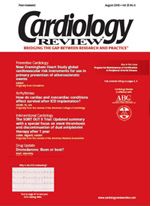Publication
Article
Cardiology Review® Online
A few simple precautions can avoid flushing with niacin
Lipid disorders
New York City—Flushing episodes with niacin can be managed with a few simple precautions, said Allen J. Taylor, MD, at the 2nd International Symposium on Triglycerides and HDL: Role in Cardiovascular Disease and the Metabolic Syndrome.
Niacin is currently the most potent therapy available to raise high-density lipoprotein (HDL) cholesterol, resulting in increases as high as 35%; when used in combination with an HMG-CoA reductase inhibitor (statin), it has the potential to reduce cardiovascular risk more so than statin monotherapy, said presenters at the meeting.
Flushing has traditionally limited compliance with niacin. In a study known as Arterial Biology for the Investigation of the Treatment Effects of Reducing Cholesterol (ARBITER-2), flushing occurred in 69% of niacin-treated patients compared with 13% of those assigned to placebo.
“Although most patients flush with niacin, most do so infrequently and the incidence is much less with extended-release niacin than with the sustained-release form,” said Dr. Taylor, associate professor and director of cardiovascular disease research at Walter Reed Army Medical Center, Washington, DC. “Describe the flushing as a prickly heat. Tell patients that it’s normal, harmless, and short-lived.”
Taking niacin at bedtime and with aspirin can limit the frequency and intensity of flushing. A bedtime snack may also help. Patients should also be cautioned against high-fat meals and alcohol use, which can exacerbate flushing.
If flushing does occur, “you can rapidly abort it with judicious use of nonsteroidal anti-inflammatory drugs,” he continued. “Ibuprofen, 200 mg, will knock out a flush in 10 minutes. It’s remarkably effective in patients with occasional flush.”
With the use of these simple steps, adherence to niacin exceeded 90% in ARBITER-2, he said. No elevations of liver enzymes or cases of rhabdomyolysis were observed with the use of niacin together with a statin in this study, he added.
Because vitamin E and vitamin C may blunt the effects of niacin, these vitamins should be avoided, advised Dr. Taylor.
As monotherapy, statins reduce the risk of major cardiovascular events by 30% to 35% in high-risk patients, which means that about two thirds of statin-treated patients still have a substantial risk of an event, said Ernst J. Schaefer, MD.
HDL cholesterol has been identified as an independent predictor of cardiovascular risk, raising the possibility that simultaneous treatment of HDL and low-density lipoprotein cholesterol may extend the beneficial clinical results obtained with statin monotherapy.
“We should try to target HDL cholesterol, especially if patients have established heart disease,” said Dr. Schaefer, director, Lipid and Heart Disease Prevention Program, Tufts University, Boston.
ARBITER-2 was conducted in 167 patients with known coronary heart disease (CHD) who had baseline HDL cholesterol < 45 mg/dL. The patients were randomized to once-daily extended-release niacin, initiated at 500 mg for 1 month followed by 1,000 mg, or placebo added to background statin therapy. In the placebo group, common carotid intima-media thickness (CIMT) increased from baseline to 1 year by a mean 0.044 mm (P < .001), whereas it was virtually unchanged (0.014 mm; P = .23) in the niacin group. The rate of common CIMT progression is directly associated with the risk for future myocardial infarction and CHD death, noted Dr. Taylor, who was lead investigator of the study.
Although the results of ARBITER-2 require confirmation in clinical events trials, it is the first study to show the incremental benefit of a treatment strategy that combines a statin with niacin, he said.
